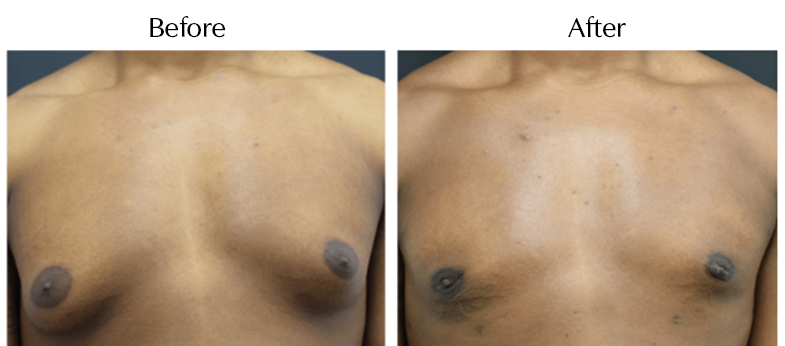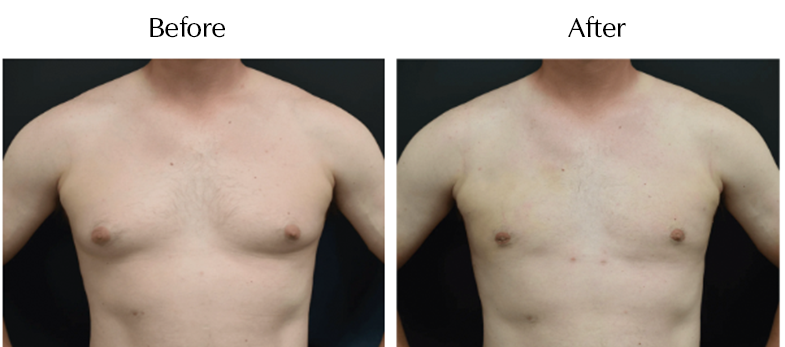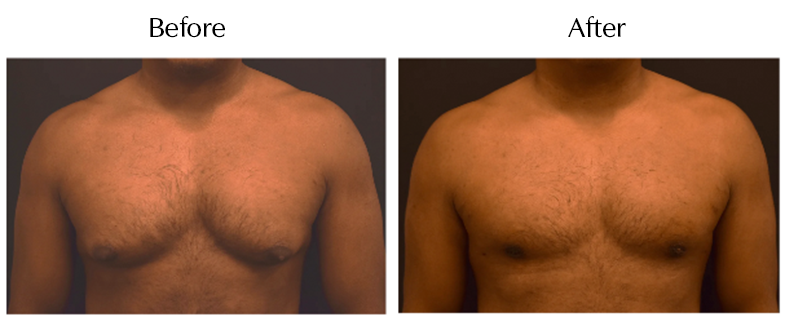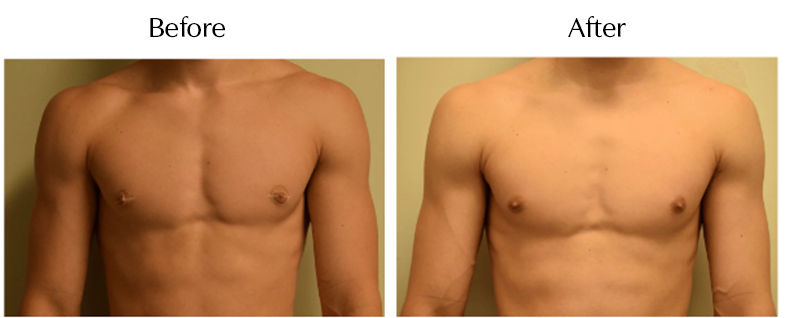Breast Reduction for Men Overview
Gynecomastia is a medical term that comes from the Greek words for women-like breasts. Though this oddly named condition is rarely talked about, it’s actually quite common. Gynecomastia affects an estimated 40 to 60 percent of men. It may affect only one breast or both. Though certain drugs and medical problems have been linked with male breast overdevelopment, there is no known cause in the vast majority of cases.
For men who feel self-conscious about their appearance, breast-reduction surgery can help. The breast surgery procedure removes fat and or glandular tissue from the breasts, and in extreme cases removes excess skin, resulting in a chest that is flatter, firmer, and better contoured.

Characteristics of Gynecomastia
Typical characteristics of gynecomastia include:
- Swelling: Noticeable enlargement of breast tissue, which can affect one or both breasts.
- Tenderness: The area may be tender or sensitive to touch, especially around the nipples.
- Asymmetry: The condition may affect one breast more than the other.
- Hormonal Changes: It can be related to hormonal imbalances, such as increased estrogen or decreased testosterone levels.
- Gradual Onset: The condition often develops slowly over time.
- Age-Related Variations: It can occur at various life stages, including puberty, middle age, or older age.
before and after photos
Some of our favorites




The Best Candidates for Male Breast Reduction
Gynecomastia surgery is a highly individualized procedure and you should do it for yourself, not to fulfill someone else’s desires or to try to fit any sort of ideal image.
This plastic surgery procedure is a good option for you if:
- You are physically healthy and of relatively normal weight
- You have realistic expectations
- Your breast development has stabilized
- You are bothered by the feeling that your breasts are too large
Surgical correction of gynecomastia is best performed on:
- Men whose condition cannot be corrected through alternative medical treatments
- Healthy individuals who do not have a life-threatening illness or medical conditions that can impair healing
- Non-smokers and non-drug users
- Men with a positive outlook and specific goals in mind for improving the physical symptoms of gynecomastia
WHY CHOOSE DR. POLAVARAPU FOR GYNECOMASTIA SURGERY
Choosing Dr. Polavarapu for your gynecomastia surgery means getting a highly skilled and dedicated professional. Her vast experience with gynecomastia procedures has earned her a reputation for delivering outstanding results that enhance confidence. Here's why Dr. Polavarapu is the top choice for gynecomastia surgery in Fort Worth:
Expertise
Dr. Kiran Polavarapu is a leading board-certified female plastic surgeon with broad expertise, top-notch training, and careful attention to detail. Her education from prestigious institutions, extensive hands-on experience in gynecomastia, and recognition for the fourth time by Fort Worth Magazine as a Top Doctor in 2025 ensure excellent outcomes. Her deep knowledge and commitment to quality guarantee that you're in capable and caring hands.
Personalized Care
Dr. Polavarapu is a gynecomastia surgeon that tailors her treatment plans to fit each patient's unique needs and goals. She listens attentively to each patient, providing personalized care from the initial consultation through post-operative recovery. Her commitment to excellence shines at every stage, as she focuses on helping you achieve your desired results with precision and care.
Advanced Techniques
Dr. Polavarapu is dedicated to using the latest techniques and technologies to deliver the best results, minimize risks, and maximize your satisfaction. Her goal is to achieve your desired outcomes with the highest level of care and accuracy.

THE PROCESS
What to Expect With Breast Reduction For Men
The initial consultation with your surgeon is very important. Your surgeon will need a complete medical history, so check your own records ahead of time and be ready to provide this information. First, your surgeon will examine your breasts and check for causes of the gynecomastia, such as impaired liver function, use of estrogen-containing medications, or anabolic steroids. If a medical problem is the suspected cause, you’ll be referred to an appropriate specialist.
Your plastic surgeon may, in extreme cases, also recommend a mammogram, or breast x-ray. This will not only rule out the very small possibility of breast cancer, but will reveal the breast’s composition. Once your surgeon knows how much fat and glandular tissue is contained within the breasts, he or she can choose a surgical approach to best suit your needs.
Don’t hesitate to ask your surgeon any questions you may have during the initial consultation- including your concerns about the recommended treatment or the costs involved. Treatment of gynecomastia may be covered by medical insurance, but policies vary. Check with your health insurance provider to be sure. If you are covered, make certain you get written pre-authorization for the treatment recommended by your plastic surgeon.
Your surgeon will give you specific instructions on how to prepare for surgery, including guidelines on eating, drinking, and taking certain vitamins and medications. Smokers should plan to stop smoking for a minimum of one or two weeks before surgery and during recovery. Smoking decreases circulation and interferes with proper healing. Therefore, it is essential to follow all your surgeon’s instructions.
Plastic surgery to correct gynecomastia is technically called reduction mammaplasty, and reduces breast size, flattening and enhancing the chest contours. In severe cases of gynecomastia, the weight of excess breast tissue may cause the breasts to sag and stretch the areola (the dark skin surrounding the nipple). In these cases the position and size of the areola can be surgically improved and excess skin may be reduced.
Medications are administered for your comfort during the surgical procedure. The choices include intravenous sedation and general anesthesia. Your doctor will recommend the best choice for you.
In cases where gynecomastia is primarily the result of excess fatty tissue, liposuction techniques alone may be used. This requires insertion of a cannula, a thin hollow tube, through several small incisions. The cannula is moved back and forth in a controlled motion to loosen the excess fat, which is then removed from the body by vacuum suction. There are various liposuction techniques that may be used; the technique most appropriate in your case will be defined prior to your procedure.
Excision techniques are recommended where glandular breast tissue or excess skin must be removed to correct gynecomastia. Excision also is necessary if the areola will be reduced, or the nipple repositioned to a more natural male contour. Incision patterns vary depending on the specific conditions and surgical preference.
Any surgical treatment to correct gynecomastia will require incisions. While most incision lines are concealed within natural contours, some may be visible and are a necessary result of breast reduction surgery.
Are Results of Gynecomastia Surgery Permanent?
Gynecomastia surgery, or male breast reduction surgery, generally provides permanent results. During the surgery, excess breast tissue is removed, which typically resolves the enlarged breast problem.
While the surgery results are typically long-lasting, factors like significant weight changes, hormonal imbalances, or certain medications could affect the outcome. Natural aging processes can also alter your body over time. However, maintaining a healthy lifestyle and following your surgeon's aftercare instructions can help your gynecomastia surgery results remain stable over time.

All Surgery Carries Some Uncertainty and Risk
When male breast-reduction surgery is performed by a qualified plastic surgeon, complications are infrequent and usually minor. Nevertheless, as with any surgery, there are risks. These include infection, skin injury, excessive bleeding, adverse reaction to anesthesia, and excessive fluid loss or accumulation. The procedure may also result in noticeable scars, permanent pigment changes in the breast area, or slightly mismatched breasts or nipples. If asymmetry is significant, a second procedure may be performed to remove additional tissue. The temporary side effects of male breast reduction include loss of breast sensation or numbness, which may last up to a year.
After Your Surgery
Post-Surgical expectations
Whether you’ve had excision with a scalpel or liposuction, you will feel some discomfort for a few days after surgery. Discomfort can be controlled by following your doctor's post-operative instructions and medications prescribed by your surgeon. In any case, you should arrange to have someone drive you home after surgery and to help you out for a day or two if needed.
You’ll be swollen and bruised for awhile–in fact, you may wonder if there’s been any improvement at all. To help reduce swelling, you’ll probably be instructed to wear an elastic pressure garment continuously for a week or two, and for a few weeks longer at night. Although the worst of your swelling will dissipate in the first few weeks, it may be three months or more before the final results of your surgery are apparent.
In the meantime, it is important to begin getting back to normal. You’ll be encouraged to begin walking around on the day of surgery, and can return to work when you feel well enough–which could be as early as a day or two after surgery. Any stitches will generally be removed about 1 to 2 weeks following the procedure.
Your surgeon may advise you to avoid sexual activity for a week or two, and heavy exercise for about three weeks. You’ll be told to stay away from any sport or job that risks a blow to the chest area for at least four weeks. In general, it will take about a month before you’re back to all of your normal activities.
You should also avoid exposing the resulting scars to the sun for at least six months. Sunlight can permanently affect the skin’s pigmentation, causing the scar to turn dark. If sun exposure is unavoidable, use a strong sunblock.
Gynecomastia surgery can enhance your appearance and self-confidence, but it won’t necessarily change your looks to match your ideal. Before you decide to have surgery, think carefully about your expectations and discuss them frankly with your plastic surgeon.
The results of the procedure are significant and permanent. If your expectations are realistic, chances are good that you’ll be very satisfied with your new look.

Polavarapu Plastic Surgery is conveniently located on Edwards Ranch Road near the Shops at Clearfork in Fort Worth. To schedule a gynecomastia consultation with Dr. Polavarapu, please get in touch with us online, call 817-615-8576 or stop by our office.
Hours of Operation:
Monday 8:30 AM–5 PM
Tuesday 8:30 AM–5 PM
Wednesday 8:30 AM–5 PM
Thursday 8:30 AM–5 PM
Friday 8:30 AM–12:30 PM
Saturday and Sunday Closed
We look forward to seeing you.




